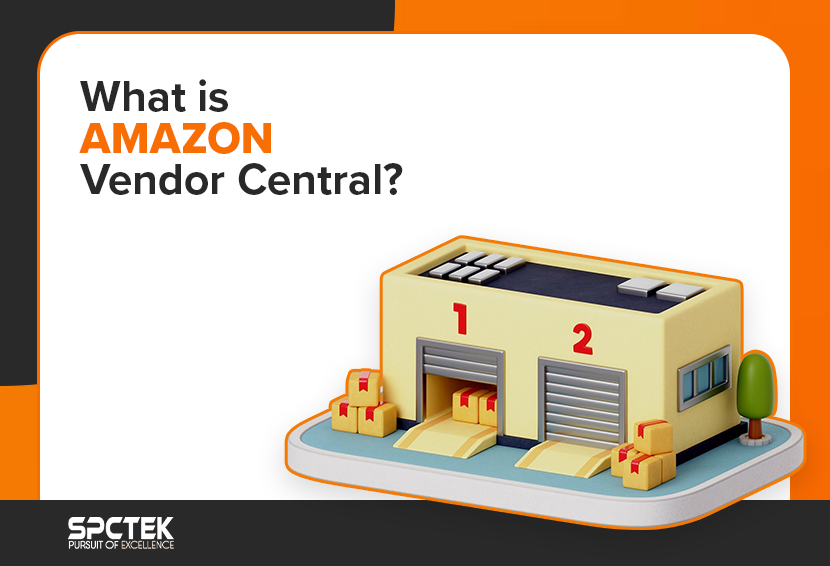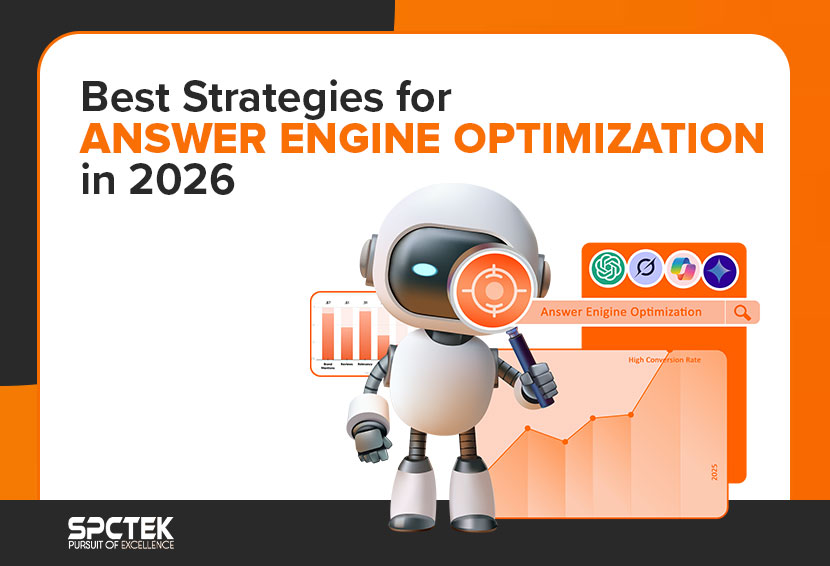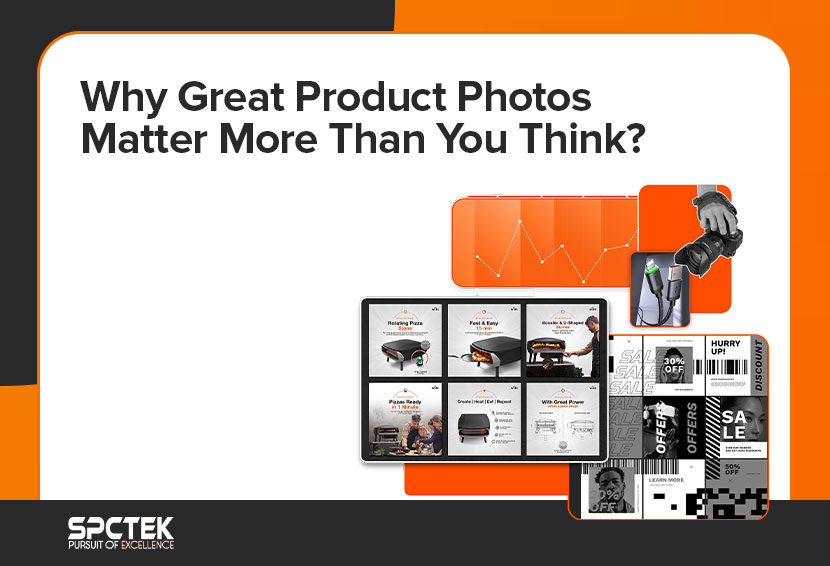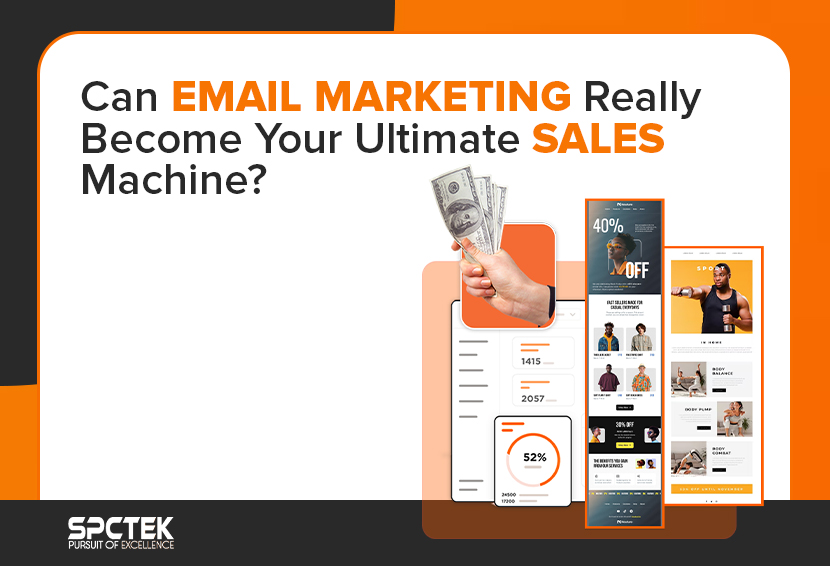If you’re looking to scale your business on Amazon, understanding the differences between Amazon’s selling platforms is crucial. One option available exclusively by invitation is Amazon Vendor Central, a wholesale model where businesses sell directly to Amazon rather than to end consumers. But what is Amazon Vendor Central, and how does it compare to Seller Central?
In this comprehensive Amazon Vendor Central Guide, we’ll break down everything you need to know, including what Amazon Vendor Central is, how it differs from Seller Central, what are the criteria for becoming an Amazon vendor, and the benefits and drawbacks of Amazon Vendor Central. Dive in to see if Vendor Central aligns with your brand goals.
What is Amazon Vendor Central?
Amazon Vendor Central is a business-to-business platform where brands sell their products wholesale directly to Amazon, making Amazon the official retailer. This model is often referred to as the “1P” or first-party relationship, because Amazon acts as the distributor.
In this setup, Amazon purchases bulk inventory from you at wholesale pricing, stores it in its warehouses, and sells it to customers. Products listed this way appear with the highly trusted ‘Ships from and sold by Amazon.com’ label, increasing buyer confidence and conversions.
Unlike Seller Central (Amazon’s third-party marketplace), Vendor Central puts you in a traditional supplier role. You don’t set pricing or control inventory visibility. However, the trade-off is access to greater volume and stronger merchandising opportunities through Amazon’s retail ecosystem.
Who is Amazon Vendor Central For? Identifying the Ideal Supplier
Amazon Vendor Central is invite-only, and Amazon typically extends invitations to:
- Large manufacturers with consistent production capacity
- National and international brands with strong customer demand
- Distributors or wholesalers with exclusive rights to in-demand products
- High-performing 3P sellers with proven sales velocity and good reviews
For instance, a vitamin brand that dominates on Seller Central with consistent sales, high review scores, and brand recognition may be offered a Vendor Central account to scale via Amazon Retail.
Ideal candidates have the operational infrastructure to meet Amazon’s compliance standards, including strict shipping timelines, electronic data interchange (EDI) capabilities, and the cash flow to handle delayed payments.
If your business is focused on B2B wholesale, mass retail partnerships, or is looking to scale without managing end-customer logistics, Vendor Central may align well with your goals.
Amazon Vendor Central vs. Seller Central: Key Differences You Need to
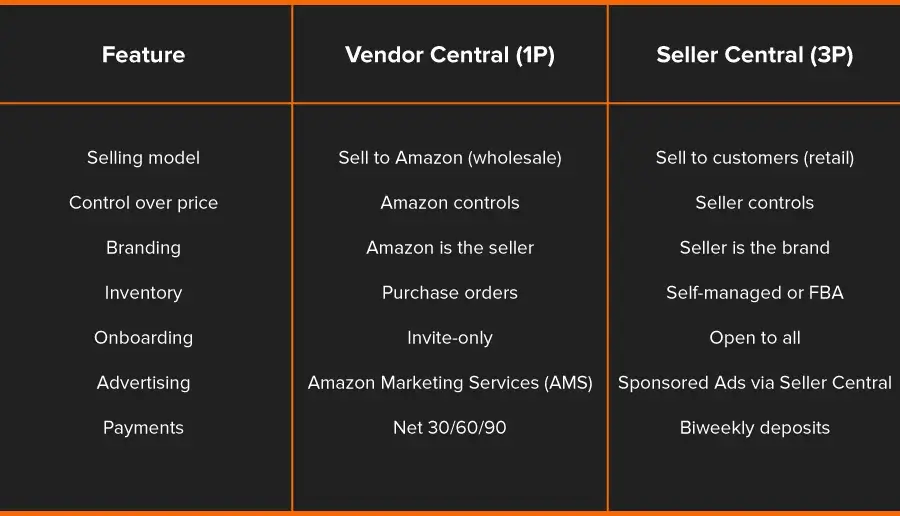
When expanding your business on Amazon, one of the biggest decisions you’ll face is whether to use Vendor Central or Seller Central. The right choice depends largely on how your brand is positioned in the market. Let’s break down the differences to help you make an informed decision.
1. Understanding the Basics: Vendor Central and Seller Central
When selling on Amazon, you can operate as either a first-party or a third-party seller.
As a first-party vendor using Vendor Central, you sell your products in bulk directly to Amazon, which then retails them to customers under its own name. These products are often labeled with a note like: “Ships from and sold by Amazon.”
As a third-party seller using Seller Central, you maintain control over your listings and can choose to fulfill orders yourself or use Fulfillment by Amazon (FBA), where Amazon handles shipping and customer service on your behalf.
Also Read: 10 Strategies for Long-Term Amazon FBA Success
2. Control Over Pricing
If pricing control is a priority, Seller Central gives you full authority to set and manage your product prices. While Amazon claims to honor MAP (Minimum Advertised Price) requests in Vendor Central, many vendors report that price reductions happen regardless to maintain Amazon’s lowest-price promise. Once prices drop, it’s difficult to raise them again. In contrast, Seller Central allows for consistent pricing control and flexibility.
3. Cost Structure and Fees
Vendor Central involves price negotiations with Amazon, which will push for the lowest wholesale prices to maximize its profit. You may also be asked to pay additional fees, such as 4-10% for slotting costs. As your sales grow, Amazon may attempt to renegotiate for better terms.
Seller Central offers a more straightforward fee structure, typically ranging from 8-20% per item sold, with additional charges for FBA if used. You maintain control and transparency over your costs.
4. Profit Margins
Vendors on Vendor Central usually operate with wholesale margins. This can be significantly lower than the retail margins available through Seller Central. Furthermore, if you’re unable to meet Amazon’s price expectations, they may seek alternative suppliers. Seller Central provides greater profit potential by enabling direct-to-consumer retail pricing.
5. Inventory Management and Stock Control
Vendor Central gives Amazon full control over stock levels, which may result in your product showing as “unavailable” without warning. This often happens as Amazon manages its risk on slow-moving products.
With Seller Central, you decide where and how to store your stock—either at an Amazon fulfillment center (if using FBA) or at your own facility. This gives you greater control and responsiveness.
6. Payment Terms and Cash Flow
Vendor Central typically operates on extended payment terms like Net 30, 60, or even 90 days, which can cause cash-flow issues. You may also need to work with third-party services to verify that Amazon has received your shipments.
In contrast, Seller Central payments are made every 7 to 14 days, after deducting fees. This regular payment schedule supports healthier cash flow and smoother business operations.
7. Customer Service Responsibility
Vendor Central offers fully managed customer service by Amazon, including handling fraud claims.
For Seller Central users, customer service responsibility is largely on the seller, unless you use FBA. Even then, you’re still accountable for complaints such as counterfeit claims.
8. International Selling Opportunities
Seller Central offers much more flexibility for global expansion. With a unified North American account, you can sell in the U.S., Canada, and Mexico, and even expand to other marketplaces worldwide.
Vendor Central, on the other hand, limits sales to the U.S. (Amazon.com). If you’re looking to scale internationally, Seller Central is the better option.
Key Takeaways
- Control: Seller Central gives you more control over pricing, branding, and fulfillment strategy, whereas Vendor Central offers simplicity but less flexibility.
- Profitability: Vendor Central generally yields lower margins due to wholesale pricing and deductions; Seller Central enables higher retail margins.
- Brand Trust: Listings sold by Amazon often carry higher consumer trust, especially in competitive niches.
Eligibility for Amazon Vendor Central
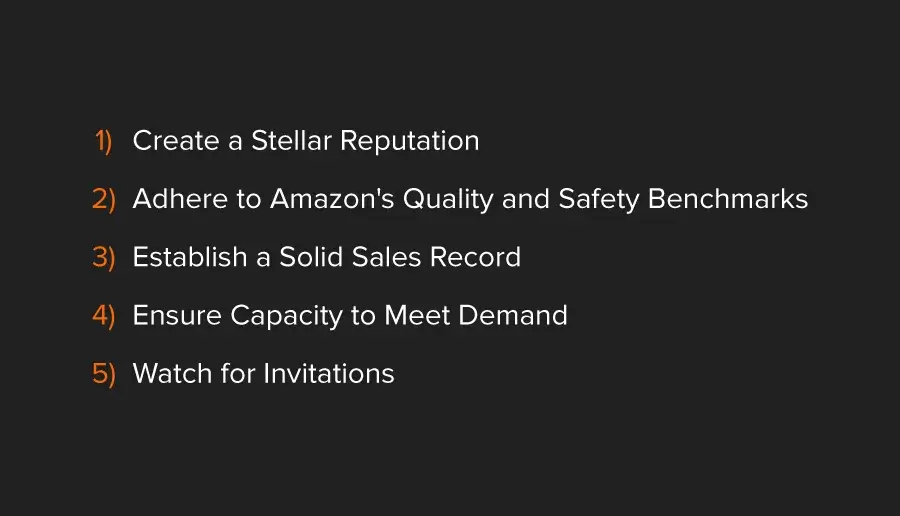
Vendor Central is an invite-only platform, meaning Amazon only invites businesses that fulfill certain criteria to sell on the platform. To be eligible for Amazon Vendor Central, you’ll want to meet specific requirements and have a solid history of selling high-quality, safe products on the Amazon marketplace. Here are some things that Amazon requires from the vendors:
1. Stellar Reputation
Amazon prioritizes businesses with a strong industry reputation and high customer regard. Concentrate on establishing a positive image by delivering top-notch products and exceptional customer service.
2. Adhering to Amazon’s Quality and Safety Benchmarks
Amazon maintains stringent standards for product quality and safety. Items failing to meet these criteria won’t be listed on the Amazon marketplace. Ensure your products comply with these benchmarks by adhering to best practices in product development and manufacturing.
3. Solid Sales Record
Amazon seeks businesses with a demonstrated history of successful product sales on their platform. Focus on building your sales record by leveraging other Amazon programs like Fulfillment by Amazon (FBA) or Seller Central.
4. Capacity to Meet Demand
Amazon prefers to collaborate with businesses capable of fulfilling orders promptly and meeting demand. Verify that you possess the necessary infrastructure and resources to handle substantial orders and adhere to delivery schedules.
What to Do After You Receive an Invitation From Amazon
Receiving an invitation from Amazon to join Vendor Central is a significant milestone. Once invited, you can begin the onboarding process by submitting key details about your business. This includes your company’s history, financial data, and product information. Amazon will conduct a thorough review and may request additional documents to verify your eligibility.
The approval process can take several weeks (or even months), depending on the complexity of your product catalog and business structure. To maximize your chances of acceptance, be comprehensive and transparent with the information you provide. Ensure your products comply with Amazon’s quality, safety, and compliance standards.
How to log into your Vendor Central account on Amazon?
Here’s how you can log into Amazon Vendor Central:
- Go to the official Amazon Vendor Central website: vendorcentral.amazon.com.
- Click the “Sign In” button at the top right corner of the page.
- Enter your email address and password linked to your Vendor Central account.
- Click the “Sign in” button to access your dashboard.
Note: Once logged in, you’ll have access to tools that support order management, payments, marketing, and advertising.
How Amazon Vendor Central works
Amazon Vendor Central account offers a suite of tools and features designed to help businesses manage their wholesale partnership with Amazon. Once enrolled as an Amazon vendor, you gain access to the Vendor Central platform, which includes the following key functionalities:
- Order management: Vendor Central serves as a centralized hub for handling orders placed by Amazon. Amazon issues purchase orders (POs) based on customer demand and sales forecasts. You ship the products to Amazon’s fulfillment centers, following strict packaging, labeling, and EDI protocols. Vendors can monitor and track purchase orders, manage inventory levels, and make updates to product listings as needed.
- Payment management: Amazon issues payments to vendors on a regular schedule for products sold. The platform provides a comprehensive view of payment records, including transaction amounts, invoice details, and payment dates.
- Marketing and advertising: Vendor Central equips vendors with various tools to promote their products on Amazon. These include the ability to create and optimize listings, run Sponsored Product campaigns, and participate in deals and promotional events to increase product visibility and drive sales.
Types of Fees You Can Expect on Amazon Vendor Central
Amazon Vendor Central fees can vary based on your product category, sales volume, and the terms you’ve negotiated with Amazon. Below are the main types of fees vendors typically encounter:
- Referral Fees: Amazon charges a referral fee for each product sold through Vendor Central. This fee is usually a percentage of the product’s sale price, ranging from 6% to 45%, depending on the product category.
- Shipping Fees: If Amazon handles shipping to customers, vendors may be responsible for additional shipping costs. These fees vary based on the size and weight of the items.
- Advertising and Marketing Fees: Vendor Central offers various marketing and promotional tools, such as Sponsored Products, Lightning Deals, and more. While these can help boost visibility and sales, they come with extra costs that vendors must budget for.
- Chargebacks and Deductions: Amazon frequently issues chargebacks and deductions for issues such as late shipments, incorrect labeling, damaged products, or customer returns. These penalties can significantly impact your bottom line.
- Payment Terms and Financial Considerations: A major shift vendors experience on Vendor Central is related to cash flow. Standard payment terms are Net 30, Net 60, or even Net 90, meaning you might not receive payment until one to three months after delivery.
Financial preparation is key: Brands should prepare for payment delays, keep meticulous EDI records, and account for potential deductions.
The Pros and Cons of Amazon Vendor Central
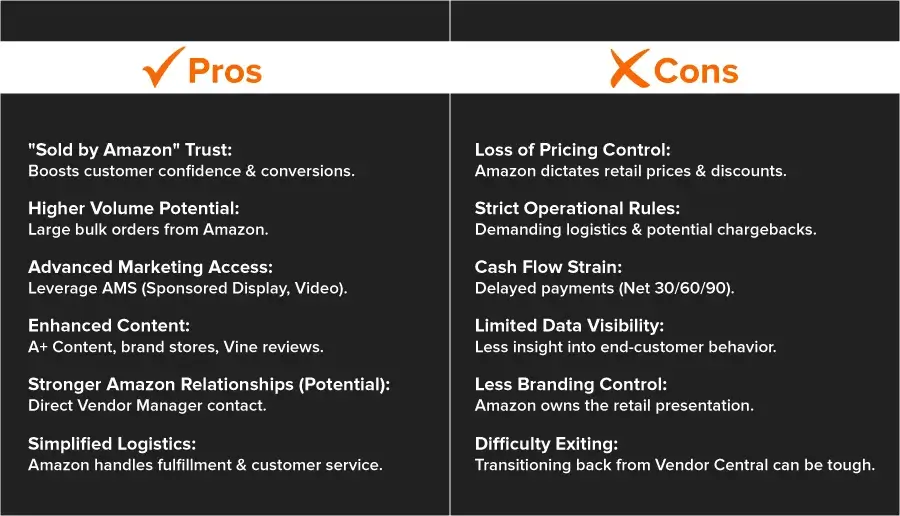
The Benefits of Vendor Central
- Higher Trust: Products appear as sold and fulfilled by Amazon, increasing conversion rates and customer trust, especially in competitive markets.
- Higher Volume Potential: Amazon can place large POs, creating significant wholesale revenue without managing end-consumer orders.
- Advanced Marketing Access: Vendors access Amazon Marketing Services (AMS), which includes premium ad types like Sponsored Display, Video Ads, and Amazon DSP.
- Enhanced Content Opportunities: Vendors can use A+ Content, brand stores, and Vine reviews, offering superior storytelling and product education.
- Amazon Support Relationships: Top-tier vendors often have direct contacts with Vendor Managers or category leads, enabling priority access to merchandising opportunities.
The Cons of Vendor Central
- Loss of Control: Amazon dictates pricing, discounting, and inventory visibility. This can lead to channel conflict with other retail partners.
- Operational Complexity: Compliance with Amazon’s logistical requirements, from packaging to EDI, is demanding and often leads to chargebacks.
- Cash Flow Strain: Delayed payments (up to 90 days) can challenge small manufacturers.
- Limited Visibility: You don’t have real-time visibility into end-customer behavior. Data is limited compared to what Seller Central offers.
- Getting Out Isn’t Easy: Once you’re in Vendor Central, transitioning back to Seller Central may require negotiations and could disrupt your ASIN listings.
Maximizing Your Success on Amazon Vendor Central: Strategies for Suppliers
1. Optimizing Product Listings for Vendor Central
Although Amazon has primary control over your product listings, there are still key areas where vendors can influence performance. Utilizing high-quality product images, well-written and SEO-optimized copy, and engaging A+ Content can help boost visibility and conversions. Want to learn how A+ Content can help? Check out our practical A+ Content guide.
Collaborate closely with your Vendor Manager to ensure that your product titles, bullet points, and backend keywords are fully optimized. Additionally, submitting enhanced brand content is a great way to maintain your brand voice and educate potential customers. Teams.
2. Leveraging Amazon Advertising for Vendors (AMS)
Vendors on Amazon have access to powerful advertising tools through Amazon Marketing Services. Investing in Sponsored Brands can help generate top-of-funnel traffic and introduce new shoppers to your brand.
Sponsored Display ads are effective for retargeting potential customers who have previously viewed your products, even outside of Amazon’s ecosystem.
For more advanced targeting and broader brand exposure, Amazon DSP allows for highly segmented advertising strategies. For example, a gourmet snack brand could use DSP to specifically target shoppers interested in “gluten-free” products, helping to drive sales of its organic product line.
Also Read: Amazon Ad Types and Their Benefits: A Complete Guide
3. Building a Strong Relationship with Amazon
Success on Vendor Central is closely tied to the quality of your relationship with Amazon. Proactively engage with your Vendor Manager by sharing insights, sales data, promotional calendars, and ideas for new product launches.
Meeting Amazon’s compliance standards is essential to avoid chargebacks and financial deductions. When your operations align with Amazon’s growth goals and demonstrate consistent reliability, you build trust, leading to increased support and potential investment from Amazon.
4. Managing Your Inventory Effectively
Inventory management is vital to meeting customer demand and avoiding stockouts. Use the inventory tracking and forecasting tools available in Vendor Central to stay ahead of demand and maintain optimal stock levels. A proactive inventory strategy helps ensure product availability and customer satisfaction.
5. Monitoring Your Performance Metrics
Vendor Central provides detailed analytics, including sales performance, customer feedback, and return data. Regularly reviewing these metrics allows you to assess the effectiveness of your strategies and make informed adjustments. Staying data-driven is essential for maintaining and improving performance over time.
Also Read: 10 Best Amazon Inventory Management Strategies: Updated Guide
Final Thoughts
Navigating the Amazon ecosystem can be complex, especially when choosing between Vendor Central and Seller Central. This Amazon Vendor Central Guide outlines the key differences to help you make a well-informed decision based on your business model, pricing flexibility, and desired level of control.
So, what is Amazon Vendor Central really? It’s a powerful tool for brands looking to scale quickly through wholesale partnerships with Amazon, but it also comes with trade-offs in pricing, support, and profit margins. Evaluate your goals carefully, and use this guide as your foundation for choosing the right Amazon selling strategy.
Got More Questions?
You can only become an Amazon Vendor by invitation. Typically, Amazon reaches out to manufacturers, brand owners, or large-scale distributors with a proven track record.
An Amazon Vendor Central account is granted only after receiving an invitation from Amazon. Once invited, you’ll go through an application process where Amazon reviews your business history, financials, and product catalog. Upon approval, you’ll gain access to the Vendor Central platform.
Manufacturers benefit from Vendor Central by selling their products in bulk directly to Amazon, which handles pricing, fulfillment, and customer service. Listings marked “Sold by Amazon” often earn more trust from shoppers, and the model can help manufacturers focus on production rather than retail logistics.
Once you’re approved, Amazon will issue purchase orders for the products it wants to buy. You ship those items to Amazon’s fulfillment centers, and Amazon sells them to consumers under its own brand. Your involvement in day-to-day retail operations is minimal as Amazon manages listings, pricing, and shipping.
Yes, while Vendor Central offers convenience and scale, it comes with trade-offs. You lose pricing control, profit margins may shrink due to wholesale pricing and fees, and support is limited unless you’re a high-volume brand. Additionally, cash flow can be impacted by longer payment terms.

